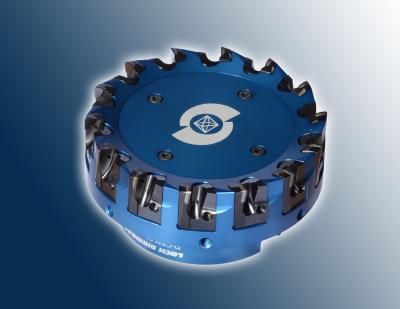
LACH DIAMOND introduces its newly developed PCD cartridge milling cutter »dia-blue-power«. A PCD monoblock milling cutter with brazed cutting edges, chip and shear angle and a large chip space created the basis for better performance and cost reductions in the automobile and composite industries, according to the company.
LACH DIAMOND’s PCD monoblock milling cutters proved their performance due to an extremely high number of teeth up to 100 mm in diameter in aluminum machining, but the »dia-blue-power« will utilize its advantages for diameters from 125 to 450 mm. With feed speeds of over 30.000 mm/min, this PCD tool is ideal for tasks during HPC/HSC edge and facemilling of nonferrous metals and composite materials.
The form-locking pressure pieces feature a radially shaped machining area with a possible teeth number from Z14 to Z56 and allow for maximal machining performance of up to 6 mm compared to standard infeeds of maximal 1.5 mm in one run. This also means that users of a PCD cartridge milling cutter »dia-blue-power« will save up to 2/3 time compared to similar models.
As for PCD monoblock milling cutters, LACH DIAMOND provides even better performance and cleanliness at the components via two additional options, »Cool Injection« and »chip breaker Plus«.
»dia-blue-power« is recommended for HSC/HPC machining with speeds up to vc = 6000 m/min and feeds up to vf = 30 m/min.
Contact Details
Related Glossary Terms
- facemilling
facemilling
Form of milling that produces a flat surface generally at right angles to the rotating axis of a cutter having teeth or inserts both on its periphery and on its end face.
- feed
feed
Rate of change of position of the tool as a whole, relative to the workpiece while cutting.
- gang cutting ( milling)
gang cutting ( milling)
Machining with several cutters mounted on a single arbor, generally for simultaneous cutting.
- milling
milling
Machining operation in which metal or other material is removed by applying power to a rotating cutter. In vertical milling, the cutting tool is mounted vertically on the spindle. In horizontal milling, the cutting tool is mounted horizontally, either directly on the spindle or on an arbor. Horizontal milling is further broken down into conventional milling, where the cutter rotates opposite the direction of feed, or “up” into the workpiece; and climb milling, where the cutter rotates in the direction of feed, or “down” into the workpiece. Milling operations include plane or surface milling, endmilling, facemilling, angle milling, form milling and profiling.
- milling cutter
milling cutter
Loosely, any milling tool. Horizontal cutters take the form of plain milling cutters, plain spiral-tooth cutters, helical cutters, side-milling cutters, staggered-tooth side-milling cutters, facemilling cutters, angular cutters, double-angle cutters, convex and concave form-milling cutters, straddle-sprocket cutters, spur-gear cutters, corner-rounding cutters and slitting saws. Vertical cutters use shank-mounted cutting tools, including endmills, T-slot cutters, Woodruff keyseat cutters and dovetail cutters; these may also be used on horizontal mills. See milling.
- polycrystalline diamond ( PCD)
polycrystalline diamond ( PCD)
Cutting tool material consisting of natural or synthetic diamond crystals bonded together under high pressure at elevated temperatures. PCD is available as a tip brazed to a carbide insert carrier. Used for machining nonferrous alloys and nonmetallic materials at high cutting speeds.
